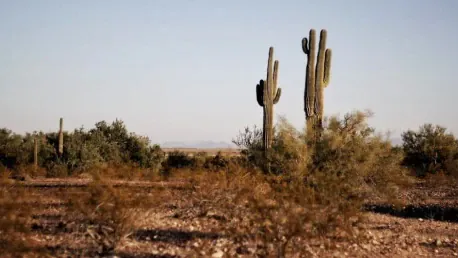In the modern era, the urgent need to address climate change and its intersecting impact on biodiversity loss has never been more critical. Tackling these dual crises requires a well-balanced approach that incorporates both renewable energy development and wildlife conservation. The National Audubon Society’s “Survival by Degrees” report underscores the alarming statistic that 61 percent of bird species in North America are at risk of extinction under a 3-degree climate warming scenario. Specifically, species such as Clark’s Nutcracker, Montezuma Quail, and Eared Grebes in Arizona face considerable vulnerability, highlighting the necessity for immediate, comprehensive action.
Integrating Renewable Energy and Wildlife Conservation
The Need for Renewable Energy Infrastructure
The construction of industrial-scale renewable energy projects is indispensable for significantly reducing carbon emissions and combating climate change. Developing solar farms, wind turbines, and other renewable energy infrastructures can substantially limit our dependence on fossil fuels. However, this should not come at the expense of natural habitats. The renewable energy sector’s expansion presents an opportunity to leverage technological advancements and innovative design to mitigate negative impacts on wildlife and their ecosystems.
One of the critical steps in achieving this balance involves proactive engagement with impacted communities. While the development of renewable energy infrastructure offers considerable environmental benefits, it is essential to address the concerns of those living in proximity to these projects. Community input can lead to more refined, effective siting and design strategies that benefit everyone involved. Public consultations, stakeholder meetings, and collaborative decision-making processes are vital in ensuring a harmonious outcome that supports both renewable energy goals and habitat conservation.
Arizona and the Southwest’s Crucial Role
Arizona, along with the broader Southwest, stands out as a key region in these conservation efforts. This area boasts abundant solar and wind resources, making it an ideal location for renewable energy projects. The Audubon Society, particularly through Audubon Southwest, has taken an active role in advocating for responsible renewable energy development in this region. They have endorsed initiatives like the Sunzia Transmission Line and the Bureau of Land Management’s Western Solar Plan, ensuring that the projects align with conservation principles.
In their efforts, Audubon Southwest emphasizes the importance of utilizing scientific research and engaging with industry partners to influence the siting and permitting processes effectively. By integrating conservation science into the early planning stages, these projects can minimize their impact on local bird populations and other wildlife. The collaborative approach aims to avoid the counterproductive narrative that positions renewable energy development against wildlife protection. Instead, with smart, informed strategies, both objectives can be achieved simultaneously.
Practical Strategies for Harmonizing Objectives
Leveraging Existing Infrastructure
One practical strategy to harmonize renewable energy goals with conservation objectives involves maximizing the capacity of existing transmission lines before constructing new ones. Optimizing current infrastructure can efficiently distribute renewable energy without further encroaching on natural habitats. This approach not only conserves resources but also reduces the environmental footprint associated with new construction. Moreover, existing lines can often be upgraded or modernized to handle greater loads, thereby enhancing their efficiency and reliability.
Rooftop solar installations, home battery storage systems, and energy efficiency improvements are additional solutions that can alleviate the pressure on wildlife habitats. These decentralized energy options allow households and businesses to generate their power, reducing the need for extensive infrastructural development. By promoting these alternatives, conservation organizations can support a distributed energy model that benefits both wildlife and human communities. The resulting decentralized network is resilient and adaptable, contributing to broader sustainability and conservation goals.
Encouraging Public Engagement
Public participation plays a crucial role in advancing both renewable energy initiatives and wildlife conservation efforts. Audubon Southwest encourages individuals to stay informed and involved through their news and action alerts. By raising public awareness, they aim to build a support base that champions balanced, responsible approaches to energy and conservation challenges. This grassroots involvement ensures that the voices of concerned citizens are heard in decision-making processes.
Educational campaigns and advocacy are essential tools in this endeavor. Informing the public about the interconnectedness of climate change and biodiversity loss fosters a deeper understanding of the stakes involved. Furthermore, highlighting successful examples of balanced projects can inspire broader acceptance and implementation of such practices. Advocacy efforts often extend beyond local initiatives, influencing policy at state and national levels, thus bringing about broader systemic changes.
Conclusion
In today’s world, the urgent necessity to confront climate change and its overlapping effects on biodiversity loss cannot be overstated. Addressing these dual crises demands a balanced strategy that embraces both renewable energy expansion and wildlife conservation. The National Audubon Society’s “Survival by Degrees” report highlights that an alarming 61 percent of bird species in North America face extinction risks if the climate warms by 3 degrees Celsius. This statistic underscores the critical need for immediate, comprehensive action. Regional species like Clark’s Nutcracker, Montezuma Quail, and Eared Grebes in Arizona exemplify this vulnerability, indicating that proactive measures are essential to preserve biodiversity. Furthermore, the consequences of inaction extend beyond individual species, threatening entire ecosystems and the services they provide. As such, it’s imperative to integrate climate policies and conservation efforts, ensuring both environmental and economic sustainability. Only through these coordinated actions can we hope to mitigate the impending crises effectively.









